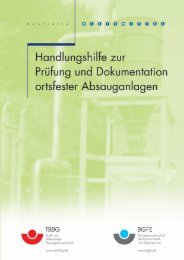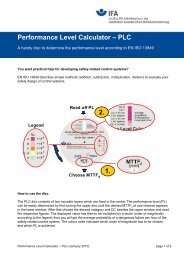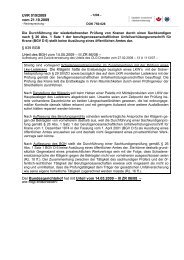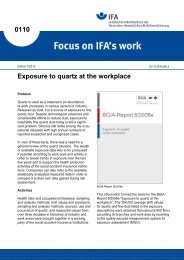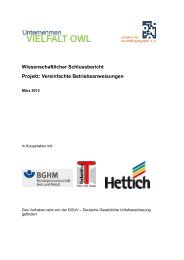Effectiveness of measures to prevent needlestick injuries among ...
Effectiveness of measures to prevent needlestick injuries among ...
Effectiveness of measures to prevent needlestick injuries among ...
Create successful ePaper yourself
Turn your PDF publications into a flip-book with our unique Google optimized e-Paper software.
4 Intervention program evaluation<br />
mented educational program. It was not possible, therefore, <strong>to</strong> conclude that changes<br />
in reported injury rates were the result <strong>of</strong> box relocation, increased safety awareness or<br />
changes in knowledge resulting from the educational program, or uncontrolled con-<br />
founding.<br />
Edmond et al. placed observers <strong>to</strong> record needle recapping by nurses before and after<br />
relocation <strong>of</strong> needle disposal boxes [73]. The observed rates <strong>of</strong> recapping both before<br />
and after relocation <strong>of</strong> the boxes held steady at higher than 90 %, suggesting either<br />
that this was a uniquely non-compliant population or that the presence <strong>of</strong> the observ-<br />
ers affected the nurses’ behavior more than placement <strong>of</strong> the disposal boxes.<br />
� Rigid disposal containers<br />
The pre-post intervention comparison was also used by all four <strong>of</strong> the studies within<br />
this subgroup assessing the effectiveness <strong>of</strong> transitioning from cardboard disposal<br />
boxes <strong>to</strong> impermeable plastic boxes [43; 77 <strong>to</strong> 79]. None <strong>of</strong> these evaluations ade-<br />
quately addressed the concern about concurrent changes in practice, policy or back-<br />
ground risks (e. g. due <strong>to</strong> changes in staffing levels). All relied on self-reported <strong>injuries</strong>,<br />
potentially introducing bias if reporting practices changed during the observation<br />
period independent <strong>of</strong> the change <strong>to</strong> rigid disposal containers.<br />
D’Arco et al. rated poor, implemented several interventions at the same time, includ-<br />
ing safety training and improvements <strong>to</strong> injury reporting systems, in addition <strong>to</strong> the<br />
transition <strong>to</strong> rigid disposal containers [43]. Though a decrease in the needle stick<br />
injury rate was observed, it was not possible <strong>to</strong> conclude that the decrease was attrib-<br />
utable <strong>to</strong> the new disposal boxes.<br />
Smith et al. judged <strong>to</strong> be <strong>of</strong> intermediate quality, reported no change in injury rates<br />
following introduction a plastic sharps disposal box [79]. However, they did note that<br />
the number <strong>of</strong> needle containing devices used increased 13.5 % over the observation<br />
period. Therefore, a constant incidence <strong>of</strong> needle stick <strong>injuries</strong> may actually be indica-<br />
tive <strong>of</strong> a decreased risk, since exposure had increased. The analyses presented by the<br />
authors were inadequate <strong>to</strong> reach a firm conclusion, however.<br />
Ribner et al. and Krasinski et al. both <strong>of</strong> intermediate quality, provided slightly more<br />
evidence <strong>of</strong> the potential protective effect <strong>of</strong> rigid containers as compared <strong>to</strong> card-<br />
Report „Needlestick <strong>injuries</strong>“ 50



